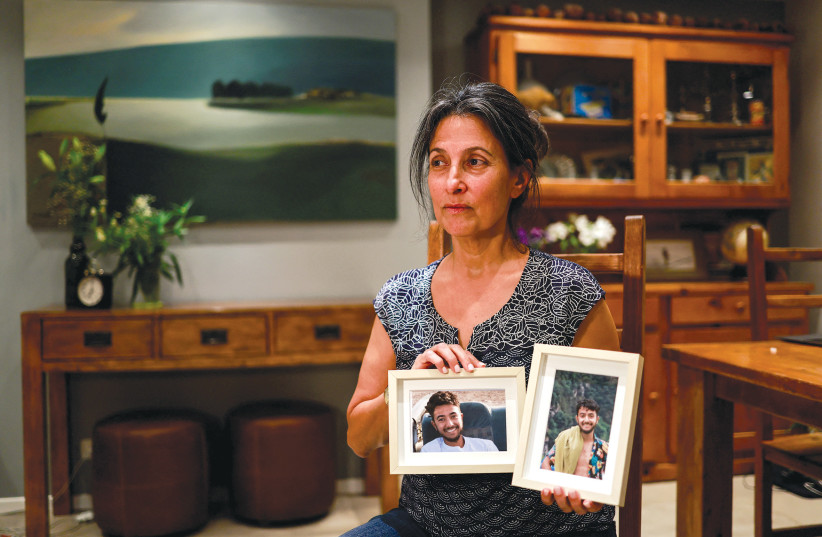In front of the Tel Aviv Museum of Art, a long table that seems to go on forever is set with empty white plates, wine glasses, and chairs – including high chairs – one for each of the 203 hostages believed to be held by Hamas in Gaza. (That number has since been updated to 222). A single white rose adorns the table. On each chair is the poster of a hostage. Called The Empty Shabbat Table, the exhibit shows how the plight of the hostages has captured the Israeli psyche more than any other aspect of the war.
Hamas released two hostages – Judith and Natalie Raanan from Evanston, Illinois – last weekend after Qatari mediation. The two were visiting family on Kibbutz Nahal Oz when they were kidnapped but do not live in Israel. Their release raised hope that Hamas would release at least the captured women and children in the coming days.
While Israel has had hundreds of POWs held by Jordan, Egypt, and Syria after various conflicts in the past, they were soldiers. And, of course, there was Israeli soldier Gilad Schalit, captured by Hamas in a cross-border raid from Gaza in 2006 and released five years later in exchange for 1,000 Palestinian prisoners.
Hostages in the past were soldiers, now civilians
But this is the first time that civilians have been abducted. The Israeli army says that among the hostages are 30 children under the age of 16, and between 10 and 20 over the age of 60. They believe that most of the hostages held in Gaza are still alive, although the only concrete proof of life came from a video of French-Israeli citizen Mia Schem, 20, shown receiving medical treatment in a hospital. It was not clear when the video was filmed.

The hostages’ families have embarked on a wide-ranging PR campaign with the hashtag Bringthemhomenow#. Among the hostages are dozens of dual citizens of the US, France, and the UK, such as Hersh Goldberg-Polin, whose parents Rachel and Jon were on the cover of this week’s Time magazine. They made aliyah from Berkeley, California, when Hersh was seven.
The Goldberg-Polins have told their story numerous times – how Hersh left their home after Shabbat dinner to go to the music festival with his best friend Aner Shapira.
How they ran with dozens of other young people into a shed as the massacre started. How the gunmen lobbed grenades into the shed and Aner caught them and threw them back before being killed by one. How Hersh’s left arm was blown off at the elbow, and he fashioned a tourniquet from his shirt. How he was conscious when he was taken captive by Hamas. Hersh’s story has captivated the estimated 200,000 Israeli-Americans in Israel.
“I feel in a certain way that I raised my kids in parallel to the Goldberg-Polins,” Michael Caplan, a family friend, told The Jerusalem Report. “They were our neighbors when they moved here from California. We spent numerous Pesachs with them at Ramah Darom near Atlanta, Georgia. We’ve been to their apartment for Shabbat meals. They’ve been to ours. My eldest taught their son how to ride a bike. Hersh and my youngest were classmates in high school.”
He says Hersh’s story has only strengthened his resolve in the fight against Hamas.
“My son is an officer in Givati. He will soon be tasked with leading his troops into Gaza,” Caplan said. “The mission is twofold: to cleanse the world from the entity known as Hamas. And to bring his classmate Hersh, and the rest of the kidnapped men, women, and children, home.”
Another dual citizen held hostage is Israeli-Canadian Vivian Silver, 74, a long-time peace activist who has lived on Kibbutz Be’eri for decades. In 2000, she founded the Arab-Jewish Center for Empowerment, Equality, and Cooperation (known locally as AJEEC-NISPED), which works to create a shared society of Jewish and Arab citizens in Israel. She also volunteered with Road to Recovery, an organization that transports Palestinian patients to hospitals in Israel. Whenever she had a meeting in Jerusalem, she would drive patients from the Gaza border to hospitals in Jerusalem.
“I’m praying for the health of her soul, not only her body,” Yael Noy, the director of Road to Recovery, told The Jerusalem Report. “We have several of our volunteers that are being held by Hamas.”
It is hard to fathom how families with young children in Gaza are managing. Several children were taken without their parents. At the Defense Ministry in Tel Aviv, families have covered a wall with posters and set up a protest tent across the street. One of the most prominent is Kfir Bibas, nine months old, and his brother, Ariel, age four .
The families say that for 10 days nobody from the government even contacted them, although Prime Minister Benjamin Netanyahu has since appointed Gal Hirsch as the coordinator for the hostages.
Israeli volunteers to help find the hostages got together almost immediately. Karin Nahon, a professor of information sciences at Reichman University, quickly gathered hundreds of volunteers, many of them in hi-tech fields, to scour the Internet looking for any clues as to the whereabouts of the hostages. They have set up a well-organized war room at the Tel Aviv Expo grounds.
“Israeli citizens from all kinds of different sectors – from technology, interrogation, and social networks – are gathered here to try to create a full image of what’s going on,” Nahon told The Jerusalem Report.
Until just a few weeks ago, Nahon was one of the leaders of the protest movement against Prime Minister Netanyahu’s judicial overhaul plan. Now she is using her organizational skills to help find missing Israelis. She says that the information her volunteers have provided has helped locate dozens of the hostages. ■
